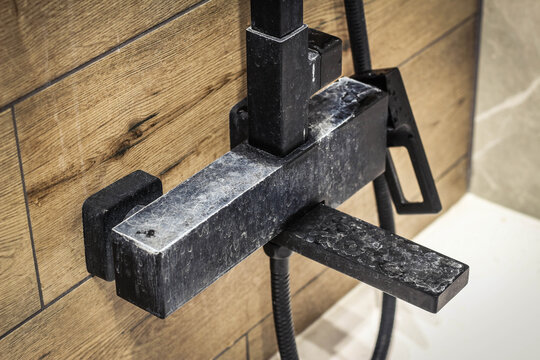
Black taps are a stylish and modern addition to any kitchen or bathroom, adding a touch of sophistication to the decor. However, one common issue with black taps is the buildup of limescale, which can mar their sleek appearance. Limescale is a hard, chalky deposit primarily made up of calcium carbonate, often found in areas with hard water. It can make your taps look dull and unattractive. This guide will provide you with comprehensive steps on how to remove limescale from black taps effectively and maintain their pristine look.
Understanding Limescale
Limescale forms when hard water evaporates, leaving behind calcium and magnesium deposits. These deposits can build up over time, especially on surfaces that frequently come into contact with water, such as taps and showerheads. Besides being unsightly, limescale can also affect the functionality of your taps, reducing water flow and causing damage over time.
Tools and Materials Needed
Before you start the cleaning process, gather the following tools and materials:
- White vinegar
- Lemon juice
- Baking soda
- Soft cloths or microfiber cloths
- Non-abrasive sponge
- Old toothbrush
- Spray bottle
- Plastic bag
- Rubber bands
- Soft-bristle brush
Step-by-Step Guide to Removing Limescale from Black Taps
1. Preparation
Before you begin cleaning, ensure that you have all necessary materials at hand. Also, make sure the area around the tap is clear to avoid any damage or mess.
2. Basic Cleaning
Start with a basic cleaning to remove any surface dirt and grime. Use a soft cloth dampened with warm water and a mild dish soap. Gently wipe down the taps to remove any loose debris.
Steps:
- Dampen a soft cloth with warm, soapy water.
- Gently wipe the entire surface of the black tap.
- Rinse with clean water and dry with a microfiber cloth.
3. Using White Vinegar
White vinegar is a natural and effective limescale remover. However, vinegar can be acidic and may damage certain finishes, so it’s essential to test it on a small, inconspicuous area first.
Steps:
- Mix equal parts of white vinegar and water in a spray bottle.
- Spray the solution onto the limescale-affected areas of the tap.
- Let it sit for about 15-20 minutes to break down the limescale deposits.
- Use a non-abrasive sponge or a soft cloth to gently scrub the area.
- Rinse thoroughly with water and dry with a microfiber cloth.
4. Lemon Juice and Baking Soda
For more stubborn limescale deposits, a combination of lemon juice and baking soda can be very effective. Lemon juice is acidic and helps dissolve limescale, while baking soda acts as a mild abrasive to scrub away deposits without scratching the surface.
Steps:
- Squeeze fresh lemon juice onto the limescale deposits.
- Let it sit for 5-10 minutes.
- Sprinkle baking soda over the lemon juice.
- Use an old toothbrush or a soft-bristle brush to scrub the area gently.
- Rinse thoroughly with water and dry with a microfiber cloth.
5. Using a Plastic Bag for Difficult Areas
For hard-to-reach areas or for heavily scaled taps, you can use a plastic bag filled with vinegar.
Steps:
- Fill a plastic bag with white vinegar.
- Place the bag over the tap, ensuring the limescale-affected areas are submerged in vinegar.
- Secure the bag with rubber bands.
- Let it sit for at least an hour.
- Remove the bag and scrub the area with a non-abrasive sponge or a soft cloth.
- Rinse thoroughly with water and dry with a microfiber cloth.
6. Commercial Limescale Removers
If natural remedies are not effective, you can use commercial limescale removers specifically designed for black taps. Ensure that the product is safe for your tap’s finish by reading the label and performing a patch test.
Steps:
- Follow the manufacturer’s instructions on the product label.
- Apply the limescale remover to the affected areas.
- Let it sit for the recommended time.
- Scrub gently with a non-abrasive sponge or a soft cloth.
- Rinse thoroughly with water and dry with a microfiber cloth.
7. Regular Maintenance
To keep your black taps free from limescale, it’s essential to clean them regularly and take preventive measures.
Tips:
- Wipe your taps dry with a soft cloth after each use to prevent water spots and limescale buildup.
- Regularly clean your taps with a mild soap and water solution.
- Consider installing a water softener if you live in an area with hard water.
8. Preventive Measures
Taking preventive measures can significantly reduce the buildup of limescale on your black taps.
Tips:
- Use a water softener: Installing a water softener can reduce the hardness of your water, thus minimizing limescale buildup.
- Apply a protective coating: Some manufacturers offer protective coatings for taps that can help repel water and prevent limescale deposits.
- Regular cleaning: Regularly clean your taps with a mild detergent and water to prevent limescale from building up over time.
Conclusion
Removing limescale from black taps is essential to maintain their aesthetic appeal and functionality. By using natural remedies like white vinegar, lemon juice, and baking soda, or commercial limescale removers, you can effectively eliminate limescale deposits. Regular maintenance and preventive measures will help keep your black taps looking sleek and stylish for years to come. Remember to always test cleaning solutions on a small, inconspicuous area first to ensure they do not damage the finish of your taps. With the right approach, you can enjoy the beauty of your black taps without the unsightly limescale buildup.
 iVIGA Faucet Online Shop
iVIGA Faucet Online Shop
